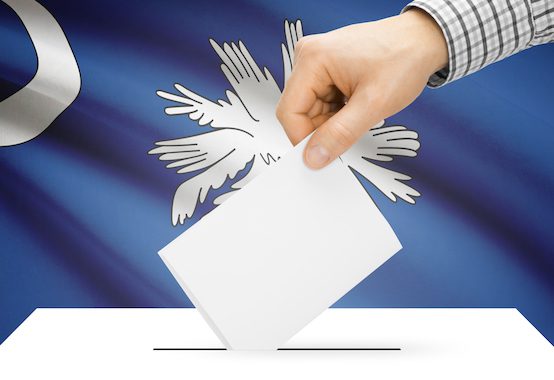Handicapping South Carolina

If you look at the Real Clear Politics chart of the average polls results for South Carolina, you’ll see a trend that looks somewhat like what Iowa looked like before the caucus, namely: Trump in the lead but dropping, and Rubio steadily rising. Trump’s lead is considerably larger than it was in Iowa pre-caucus, plus he’s held that lead in South Carolina far longer, plus South Carolina is a primary rather than a caucus. But the trend lines are still somewhat similar. So: is a similar surprise in the offing? Will Trump significantly underperform his polls? Will Rubio ride positive momentum (and endorsements by much of the state’s officialdom) to significantly outperform?
It basically depends on whose polls you believe. Thirteen different pollsters have polled South Carolina in February, but only three of them have polled the state multiple times: ARG (four times), the South Carolina House GOP (five times), and Emerson (twice). The other ten have only polled the state once this month. Since pollsters’ methodologies differ, it’s sometimes difficult to know whether an apparent trend is real if it’s generated by the entry of a different pollster.
So I took a look under the hood of the average. Here’s what I found.
First, in none of the three pollsters who polled South Carolina multiple times did I see a material trend away from Trump. In ARG’s first February poll, Trump garnered 35%; in its most recent poll, he garnered 34%. Similarly, in the first SC House GOP poll for February, Trump garnered 35%, and in the most-recent he garnered 34%. Emerson’s first February poll was much later than the other two, so it’s not really comparable, but between its two polls Trump rose from 33% to 36%.
Second, the dip that Trump has taken recently is largely driven by two polls, one from Harper covering Feb 16-17, and one from NBC/WSJ/Marist covering Feb 15-17, both of which showed Trump’s support in the high-20s rather than the mid-30s. Harper showed stronger-than-typical support for Kasich (13%), whereas the Marist poll showed stronger-than-typical support for Cruz (23%). Both actually showed weaker-than-average support for Rubio.
Third, the trend toward Rubio is most-pronounced in the ARG poll. Rubio went from 14% support in their first February poll (2/12-13) to 22% in their most recent poll (2/17-18). This move did not come at the expense of Trump, as noted above – but neither did it come at the expense of any other candidate polled. ARG has consistently shown higher support for Kasich than average (either 14% or 15% in each poll), and has consistently shown lower support for Cruz than average (ranging from 12% to 14%), but neither candidate’s numbers have moved materially in the past week. So if their finding that Rubio is surging is correct, it’s because he’s winning over voters who previously did not declare a preference (the total for the six remaining candidates went from 88% to 96% over the past week).
The SC House GOP poll, on the other hand, shows only modest movement – and that movement is toward both Rubio (up from 13% to 16%) and Cruz (up from 16% to 18%) since February 11th. This move is also fully accounted for by a drop in the percentage registering no preference (total for the six outstanding candidates went from 91% to 96% over the period). None of the other candidates moved materially over the period.
Finally, if I strip out the ARG and SC House polls, and look at the rolling average of the other pollsters, I see no move toward Rubio, a meaningful drop in Trump’s support (driven by the new Harper and Marist polls above), a modest drop in Cruz’s support – and a meaningful rise for both Bush and Kasich.
So here’s what I conclude:
- Trump is still overwhelmingly likely to win tomorrow.
- Because of the size of Trump’s lead, if he meaningfully underperforms his polls he’ll still win. But if he does meaningfully underperform, it’ll be because – as in Iowa – there was a late surge in the anti-Trump vote, rather than because his voters are switching.
- There may be real movement of late-deciders towards Rubio, such that I’d say he is favored to take second place, with Cruz coming in third. Because of Rubio’s support from the press, both mainstream and conservative, even a close second-place finish will be spun as a considerable victory, which will boost his national numbers and also his numbers in his most-winnable Super Tuesday states (most prominently Virginia, Minnesota and Colorado).
- The candidate with the most to lose right now in South Carolina is therefore Cruz. If he comes in third in South Carolina behind Rubio, he may also come in third in Nevada, and his numbers will likely weaken in states he absolutely must win on March 1st, like Oklahoma, Georgia and Arkansas, to remain viable. If Cruz does come in a strong second in South Carolina, that’ll be a sign of a strong ground game, or of a rise in support for Kasich and/or Bush at Rubio’s expense, rather than movement of voters in his direction.
- It would be a considerable surprise if either Bush or Kasich makes it into the top three – but it is not by any means impossible. Kasich has consistently placed third in the ARG poll, and Bush has polled a close fourth consistently in the SC House GOP poll. And both candidates have moved up in the past week (albeit from a low base) in the average of the other pollsters. If either Bush or Kasich beats Rubio, despite Rubio’s surge in institutional support, I’d expect Rubio to go into free-fall. If either of them beat Cruz, then ARG wins the pollster of the month award.
Comments